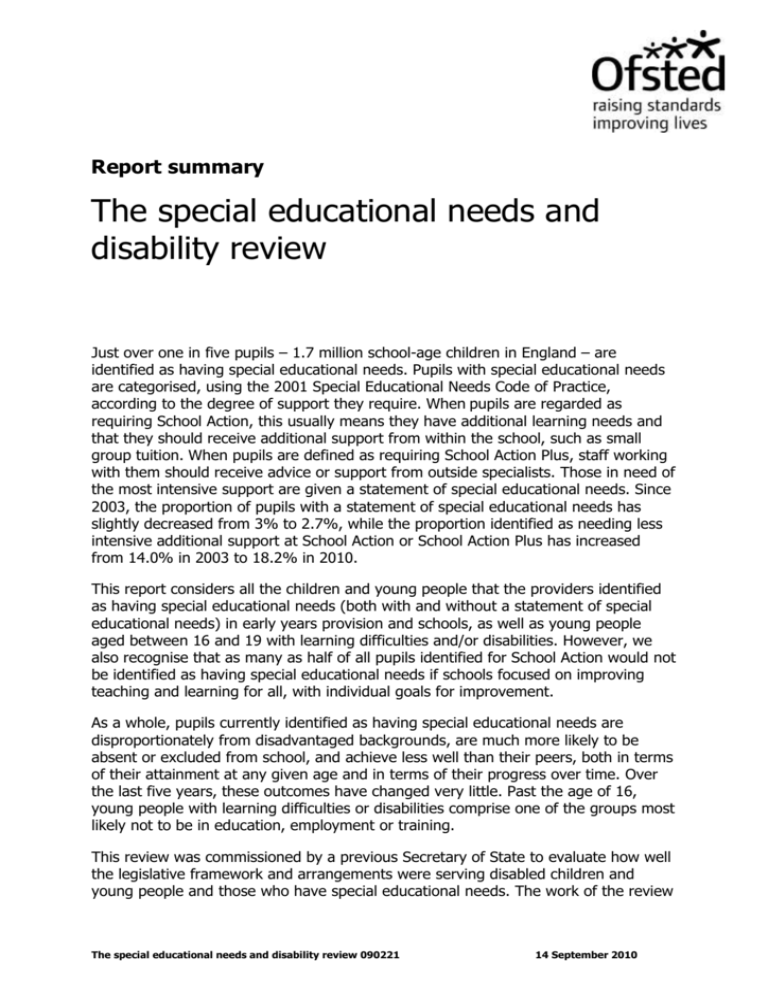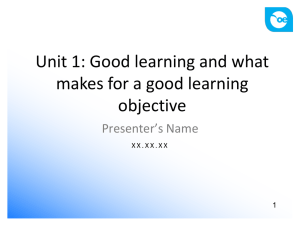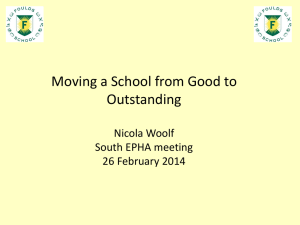Report summary
advertisement

Report summary The special educational needs and disability review Just over one in five pupils – 1.7 million school-age children in England – are identified as having special educational needs. Pupils with special educational needs are categorised, using the 2001 Special Educational Needs Code of Practice, according to the degree of support they require. When pupils are regarded as requiring School Action, this usually means they have additional learning needs and that they should receive additional support from within the school, such as small group tuition. When pupils are defined as requiring School Action Plus, staff working with them should receive advice or support from outside specialists. Those in need of the most intensive support are given a statement of special educational needs. Since 2003, the proportion of pupils with a statement of special educational needs has slightly decreased from 3% to 2.7%, while the proportion identified as needing less intensive additional support at School Action or School Action Plus has increased from 14.0% in 2003 to 18.2% in 2010. This report considers all the children and young people that the providers identified as having special educational needs (both with and without a statement of special educational needs) in early years provision and schools, as well as young people aged between 16 and 19 with learning difficulties and/or disabilities. However, we also recognise that as many as half of all pupils identified for School Action would not be identified as having special educational needs if schools focused on improving teaching and learning for all, with individual goals for improvement. As a whole, pupils currently identified as having special educational needs are disproportionately from disadvantaged backgrounds, are much more likely to be absent or excluded from school, and achieve less well than their peers, both in terms of their attainment at any given age and in terms of their progress over time. Over the last five years, these outcomes have changed very little. Past the age of 16, young people with learning difficulties or disabilities comprise one of the groups most likely not to be in education, employment or training. This review was commissioned by a previous Secretary of State to evaluate how well the legislative framework and arrangements were serving disabled children and young people and those who have special educational needs. The work of the review The special educational needs and disability review 090221 14 September 2010 began in April 2009 and has considered provision for education up to the age of 19, as well as the contribution made by social care and health services. It has focused on the accuracy and appropriateness of identification and assessment across settings and areas; expectations about potential; access to good educational provision and other services tailored to meet their needs; improvements in opportunities; and the progress made in preparing disabled children and young people and those with special educational needs for the future. At the beginning of the review, inspectors held discussions with young people and parents to understand their perspectives and concerns. They also held discussions with representative groups and service providers. Inspectors then visited 22 local authorities between May 2009 and the end of March 2010. They visited 150 providers including those from the early years private, voluntary and independent sectors; the early years maintained sector; maintained nursery, primary, secondary and special schools; non-maintained and independent special schools, including residential schools; discrete and general provision in further education colleges; independent specialist colleges; work-based learning providers, and children’s homes. Inspectors held interviews with a further 78 providers. The review team carried out 345 detailed case studies of young people’s experience of the current system. These included meetings with the children and young people and their parents or carers, as well as with the organisations working for them. The young people to whom inspectors spoke during the review were clear about what they wanted for the future: successful relationships and friendships; independence, including choice about who they lived with; choice about what to do with their spare time; and the opportunity to work. Meanwhile, parents were forthright that the current system was not helping their children adequately to achieve these goals. They were particularly concerned about what they saw as inconsistencies in the identification of the needs of young people, and getting fair access to high-quality services to meet those needs. Parents saw the current system as requiring them to ‘fight for the rights’ of their children, and they often wanted their child to be formally identified as having special educational needs – and especially to have a statement – as their guarantee of additional support. The review found that, for some children and young people, the current system is working well. In some local areas, the identification of needs was well-managed and appropriate. In some of the best examples, the non-statutory Common Assessment Framework was being used effectively to coordinate the work of a number of different organisations around the needs of a single child. Some schools and other organisations were working together and focusing on the outcomes for the young person rather than simply on what services were being provided or on their own internal priorities. What consistently worked well was rigorous monitoring of the progress of individual children and young people, with quick intervention and thorough evaluation of its impact. High aspirations and a determination to enable young people to be as independent as possible led most reliably to the best educational achievement. However, this combination of effective identification and good-quality provision was not common. The review found both widespread 14 September 2010 The special educational needs and disability review 090221 weaknesses in the quality of what was provided for children with special educational needs and evidence that the way the system is currently designed contributes to these problems. The review team found that, despite extensive statutory guidance, the consistency of the identification of special educational needs varied widely, not only between different local areas but also within them. Children and young people with similar needs were not being treated equitably and appropriately: the parental perception of inconsistency in this respect is well-founded. Across education, health services and social care, assessments were different and the thresholds for securing additional support were at widely varying levels. In some of the individual cases that inspectors saw, repeated and different assessments were a time-consuming obstacle to progress rather than a way for effective support to be provided. For children with the most obvious and severe needs, access to appropriate provision from a range of services was relatively quick and started at an early age. For young people aged between 16 and 19, identification of need and entitlement to additional provision varied across schools, colleges and post ̶ 16 training providers. The review team found that when a child was identified as having special educational needs at School Action level, this usually led to some additional help from within the school. When a child was identified as having special educational needs at School Action Plus, or especially with a statement, this usually led to the allocation of further additional resources from within and outside the school. However, inspectors found that this additional provision was often not of good quality and did not lead to significantly better outcomes for the child or young person. For pupils identified for support at School Action level, the additional provision was often making up for poor whole-class teaching or pastoral support. Even for pupils at School Action Plus level and with statements, the provision was often not meeting their needs effectively, either because it was not appropriate or not of good quality or both. Inspectors found poor evaluation by a wide range of public agencies of the quality of the additional support provided for children and young people. Too often, the agencies focused simply on whether a service was or was not being provided rather than whether it was effective. In particular, it was not enough for pupils to have a statement of special educational needs. The statement itself did not mean that their current needs were being met, but merely that they were likely to receive the service prescribed by their original statement. The achievement of disabled children and young people and those who had special educational needs was good or outstanding in less than half the providers visited and in just over one third of the case studies that inspectors undertook. The review found that no one model – such as special schools, full inclusion in mainstream settings, or specialist units co-located with mainstream settings – worked better than any other. The effective practice seen during the review encompassed a wide range of models of provision, often with significant flexibility in the way in which services were provided within any one local area. However, some providers visited during the review did not have a clear picture of the range of support available in their locality. The special educational needs and disability review 090221 14 September 2010 The pattern of local services had often developed in an ad hoc way, based on what had been done in the past rather than from a strategic overview of what was needed locally. The key implication of these findings is that any further changes to the system should focus not on tightening the processes of prescribing entitlement to services but, rather, on: improving the quality of assessment ensuring that where additional support is provided, it is effective improving teaching and pastoral support early on so that additional provision is not needed later developing specialist provision and services strategically so that they are available to maintained and independent schools, academies and colleges simplifying legislation so that the system is clearer for parents, schools and other education and training providers ensuring that schools do not identify pupils as having special educational needs when they simply need better teaching ensuring that accountability for those providing services focuses on the outcomes for the children and young people concerned. The review found a high level of demand from parents and carers for additional services for their children, and this is not something that legislative or regulatory change in itself can address easily. However, such changes could make the system better focused on the outcomes that parents and carers want for their children, and more effective in its use of necessarily limited resources. The legislation, guidance and systems around special educational needs have become very complex, and there have been significant changes to relevant legislation in education, social care and health over the last 30 years. Successive and sometimes minor additions to legislation and guidance have rarely replaced what is already there and, as a result, the system has become difficult for everyone, especially for parents and young people, to understand and navigate. Any further changes to legislation or guidance should therefore not add incrementally to the current arrangements. Instead, changes should simplify arrangements and improve consistency across different services and for children of different ages and levels of need. The review team found that the language of special educational needs has become highly contentious and confusing for both parents and professionals. Health services refer to ‘disabled’ children; social care services to ‘children in need’; education to ‘special educational needs’ or, after the age of 16, to ‘learning difficulties and/or 14 September 2010 The special educational needs and disability review 090221 disabilities’. The children and young people may find themselves belonging to more than one of these groups but the terms do not mean the same thing and they have different consequences in terms of the support that the young person will receive.1 At present, the term ‘special educational needs’ is used too widely. Around half the schools and early years provision visited used low attainment and relatively slow progress as their principal indicators of a special educational need. In nearly a fifth of these cases, there was very little further assessment. Inspectors saw schools that identified pupils as having special educational needs when, in fact, their needs were no different from those of most other pupils. They were underachieving but this was sometimes simply because the school’s mainstream teaching provision was not good enough, and expectations of the pupils were too low.2 A conclusion that may be drawn from this is that some pupils are being wrongly identified as having special educational needs and that relatively expensive additional provision is being used to make up for poor day-to-day teaching and pastoral support. This can dilute the focus on overall school improvement and divert attention from those who do need a range of specialist support. In the case of children and young people who need complex and specialist support from health and other services to enable them to thrive and develop, the term ‘educational needs’ does not always accurately reflect their situation. Both these considerations suggest that we should not only move away from the current system of categorisation of needs but also start to think critically about the way terms are used. Definitions are discussed in paragraphs 2 – 5 below. Annex A provides the terms used by different services to describe these groups of children and young people. 2 Annex B provides contextual data. 1 The special educational needs and disability review 090221 14 September 2010 Main report published 14 September 2010 www.ofsted.gov.uk/publications/090221 The Office for Standards in Education, Children's Services and Skills (Ofsted) regulates and inspects to achieve excellence in the care of children and young people, and in education and skills for learners of all ages. It regulates and inspects childcare and children's social care, and inspects the Children and Family Court Advisory Support Service (Cafcass), schools, colleges, initial teacher training, work-based learning and skills training, adult and community learning, and education and training in prisons and other secure establishments. It assesses council children’s services, and inspects services for looked after children, safeguarding and child protection. If you would like a copy of this document in a different format, such as large print or Braille, please telephone 0300 123 1231, or email enquiries@ofsted.gov.uk. You may copy all or parts of this document for non-commercial educational purposes, as long as you give details of the source and date of publication and do not alter the information in any way. To receive regular email alerts about new publications, including survey reports and school inspection reports, please visit our website and go to ‘Subscribe’. Royal Exchange Buildings St Ann’s Square Manchester M2 7LA T: 0300 123 1231 Textphone: 0161 618 8524 E: enquiries@ofsted.gov.uk W: www.ofsted.gov.uk No. 090228 © Crown copyright 2010





![afl_mat[1]](http://s2.studylib.net/store/data/005387843_1-8371eaaba182de7da429cb4369cd28fc-300x300.png)



